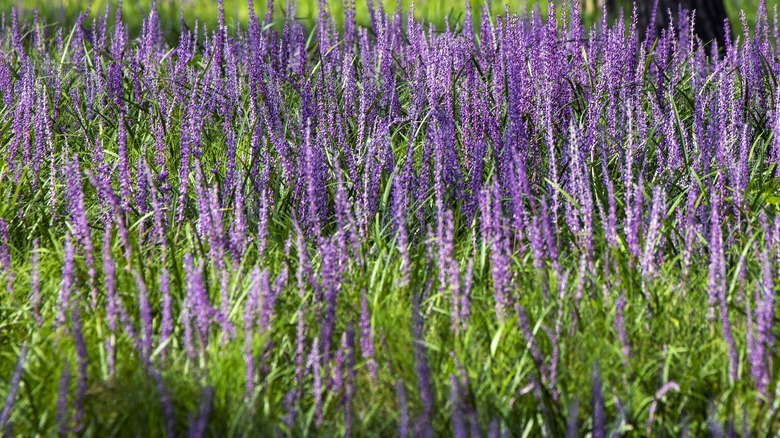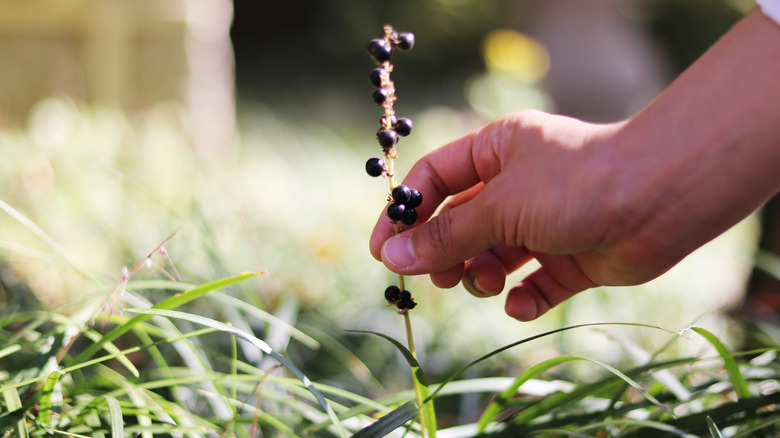The Fast-Growing Ground Cover That Will Add Beautiful Color To Your Lawn
Ground covers are the best call to cover up bare areas, fight weeds, and control soil erosion—but turfgrasses aren't your only option. While green is good, a pop of color is better, and Lilyturf (Liriope) harmonizes the two perfectly. Those down South are probably familiar with its sight and may know it as monkey grass with spiky lavender inflorescence. But this grass — which is not grass but an Asparagaceae perennial — thrives just the same up to USDA zone 4.
Starting as a tiny clump of ½-inch wide, dark green (occasionally variegated) leaves, lilyturf grows almost 2 feet tall. In the summer, it blooms under 1 inch wide, six-petaled purple, pink, or white flowers. Don't be fooled by the blooms' tiny size, as they look quite showy and full since the plant grows multiple spikes. The inflorescence ultimately gives way to shiny, bluish-black fruits shaped like berries that may survive the winter. Being evergreen, it sports lush foliage throughout the year, so you benefit from some winter interest that contrasts beautifully with the snow blanket.
Lilyturf makes a dense mat
While the colorful blooms are a win, what makes Liriope a game-changer is how well it spreads. Usually, lilyturfs spread just as wide as their height. To get a solid cover, plant the younglings 1 foot apart. However, you can space them wider, provided you're fine with the plants covering the ground a little later. Expect a jam-packed cover in two to three years when you plant them 15 to 18 inches apart — or four years if planting 2 feet across. The best part, though? You can divide the monkey grass every three to four years to get new plants—what a thrifty way to increase ground cover!
That being said, much depends on the variety you grow. This evergreen's most popular offerings include blue lilyturf (Liriope muscari) and creeping lilyturf (Liriope spicata). While both make good groundcover, muscaris grow as clumpy mounds. In contrast, because spicatas spread through rhizomes, or the underground stems, they act like creepers, eventually choking everything in their path. This makes them a poor planting choice around other flowering plants, even earning them the tag of an invasive plant in some states (Tennessee and Georgia). Simply put, think blue lilyturfs if you want the plants to stay in their lane, but choose creeping lilyturf to cover a bare, self-contained zone quickly. Fully shaded areas are an exception, as poor sunlight impedes the creeper's growth.
Other reasons for planting lilyturf
Although not an American native, Liliturf boasts an array of features that go beyond aesthetics. These flowering perennials are low-maintenance. They easily tolerate salt, cold, and heat, requiring little attention. Drought stress doesn't bother them, leading to water and money savings. Moreover, they survive in most soils, from sand to clay, as long as they're well-drained — high organic content is a plus. They aren't even picky about sunlight. Keep them in the full sun, and they'll bloom gloriously. But be ready for fewer flowers and elongated leaves if planted as understory vegetation or in gloomy, shaded areas. Another advantage is that, unlike turfgrasses, they keep pollinators, including bees, happy. Plus, you don't have to worry about pets accidentally chewing the flowers, part by part.
However, they require an annual trim in late winter after the old foliage dies down. Raise the lawnmower's setting to its highest level and prune the narrow leaves to 3 inches. Not doing so can cause a scale infestation. While they resist deer and rabbits successfully, they aren't so lucky with slugs and snails, who love to nibble them intermittently. Also, don't overwater the plants and avoid using overhead sprinklers; otherwise, they may suffer from root, leaf, or crown rot. Lilyturfs aren't a good choice in areas receiving heavy rains, as constantly wet feet make them prone to contracting anthracnose — a rabid disease that browns and kills the foliage. Lastly, they aren't fond of heavy foot traffic.


